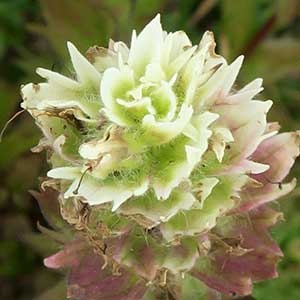Castilleja parviflora var. albida
mountain Indian paintbrush, pale small-flower paintbrush, white Indian paintbrush, white small-flower paintbrush
broadly, sometimes narrowly, lanceolate to elliptic, margins plane to ± wavy, (0–)3–5(–7)-lobed, apex acute to obtuse;
lobes ascending, lanceolate.
distally white to cream, sometimes suffused with pink to purple, 3–5(–7)-lobed;
lobes lanceolate, arising at or above mid length.
12–20(–25) mm;
tube 8–11 mm; subequal to calyx or beak exserted, 5.5–8 mm;
abaxial lip green, brown, or yellow;
teeth white to yellow, sometimes pinkish.
green to purple or red, distally white to pink, 12–17(–21) mm;
abaxial clefts (6–)7–8 mm, adaxial 8–10 mm, abaxial ca. 40% of calyx length, adaxial ca. 33% of calyx length, lateral 2–6 mm, 15–25% of calyx length;
lobes triangular, apex acute, sometimes obtuse.
Castilleja parviflora var. albida
Variety albida is found in the Cascade Range of southern British Columbia southward to the Wenatchee Mountains of Washington. In central British Columbia, the point of transition into var. parviflora still needs definition. Variety albida is characterized by whitish to cream bracts, although some plants in Okanogan County, Washington, have pink or purple bracts in mixed populations with white-bracted plants.
(Discussion copyrighted by Flora of North America; reprinted with permission.)
